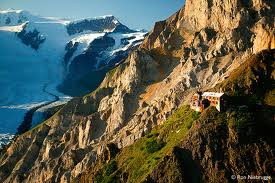 A pack trip in Wrangell-St.Elias National Park and Preserve can be an exciting and rewarding wilderness experience if the hiker is prepared for the difficulties and hazards of traveling through rugged, undeveloped land. Because there are no maintained trails within the park, travel through dense brush, across steep scree slopes and across fast and cold glacial streams and rivers can be expected. For most routes, map and compass reading skills are essential. An alternative to going it alone is to signup for a hiking trip in the park with one of the outfitters servicing the area.
A pack trip in Wrangell-St.Elias National Park and Preserve can be an exciting and rewarding wilderness experience if the hiker is prepared for the difficulties and hazards of traveling through rugged, undeveloped land. Because there are no maintained trails within the park, travel through dense brush, across steep scree slopes and across fast and cold glacial streams and rivers can be expected. For most routes, map and compass reading skills are essential. An alternative to going it alone is to signup for a hiking trip in the park with one of the outfitters servicing the area.
Weather in these vast and spectacular mountain ranges can vary to extremes in relatively short time periods. It is best to expect (and prepare for) almost any potential with a variety of layerable clothing (polypropelene, wool or pile), raingear and extra food. Summer snow storms occur at elevations of 4500 feet and above.
Trip Planning
A successful pack trip requires adequate planning. The hiker should be prepared for everything and should not count on aid or rescue from others. Caution and good judgement are key ingredients for a pleasant expedition. For many hikers, hiring the services of a local guide will make the trip safer and more enjoyable. In general, the areas above treeline (3000′) afford the easiest hiking and best views. These areas are often accessed by chartering a flight to one of the many possible “bush” landing strips. Note that there are many more places to land than are shown on maps. Air taxis will often land on gravel bars or on the tundra.
The historic trails shown on U.S.G.S. maps are often non-existent or overgrown. If you prefer not to see other people on your trip, ask a ranger or pilot about some of the lesser-known areas. A list of licensed air taxi operators is available from the park. Be flexible, and be prepared for alternative choices. Your air taxi or the Park Service may know of high water conditions, wildlife hazards, or overcrowding in an area, and they may encourage you to choose an alternative at the last minute.
Permits
Backcountry permits are not required, but travlers are encouraged to complete a”Backcountry Itinerary” available at any park office. Additionally, leave your route and expected time of return at home with your family or a friend. If you fail to check in from a backcountry trip, rangers will not initiate a search until a specific request is made. If you are flying in or out of a remote airstrip, your pilot will be your main communication link to safety. Be sure to discuss “what if” scenarios with your pilot before you are dropped off. Carry food for several extra days in case of unexpected delays. Assistance may be days or miles away, so be extraordinarily careful in this vast region.
Ask Park Service rangers or local residents about weather conditions and the reasonableness of trying to reach certain points. Walking across the spruce muskeg with a pack or crossing rivers can take much more time than expected. From a distance the landscape may look like easy hiking, but place a foot in it and you quickly find out the land tests your endurance as you hop from tussock to tussock and try to avoid hidden pools of water. On rugged, unmaintained routes, you may only travel a few miles a day.

Leave a Comment